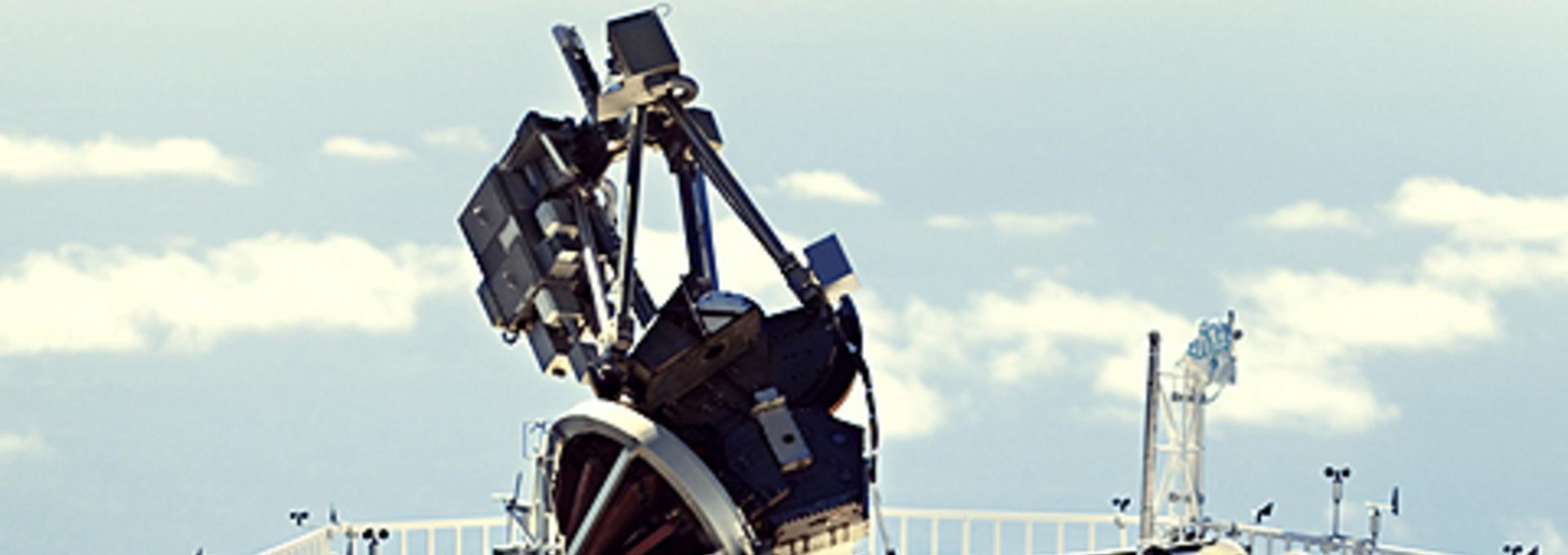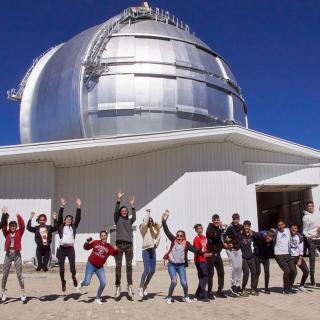Dutch Open Telescope


The DOT top is constructed with very stiff supports capable of carrying large weight. The resulting DOT aperture (shadow of the on-axis tube and support beams on the primary) is asymmetric; its unusual shape is accounted for in the speckle processing. Here is an example of the DOT + speckle transfer function (amplitude modulation transfer function averaged over many specklegrams).
The DOT secondary optics consisted initially of on-axis re-imaging lenses, focus mechanism, and analog video camera. All DOT movies from before April 2000 were made with this simple technology-demonstration system. Even at 8-bit digitization (with a PC frame grabber), speckle reconstruction was found to be feasible and worthwhile. Science-grade data followed with the installation of digital cameras.
Multi-channel observation was initiated by the installation of a second camera (the first one mounted besides the incoming beam) which observes continuum near the G-band and enables separation of granular and fluxtube motions through image subtraction, a technique that exploits the strict synchronicity of the DOT speckle imaging system (e.g. Nisenson, van Ballegooijen, de Wijn & Sütterlin, Ap. J. 587, 458, 2003).
Subsequently, an elaborate multi-wavelength system was designed using seven digital CCD cameras of which six are located, each with its own optimised re-imaging optics, in the DOT top besides the incoming beam. Here is a schematic of the DOT top. Beam splitters (including dichroic ones) divide the light between the G band (on-axis tube and camera), a continuum band near the G band, Ca II H, Halpha, a continuum band near Halpha, and Ba II 4554 with nearby continuum. Detail is given in 2003hawaii-dot.pdf.
Interference filters are used for the continua, G band and Ca II H. The Halpha beam utilises a Zeiss Lyot filter from the former Ottawa River Solar Observatory which can be tuned rapidly through the line. The similar but even narrower-band tunable Lyot filter from Irkutsk provides Ba II 4554 Dopplergrams. The narrow-band filters are mounted with telecentric re-imaging optics to produce bandpass homogeneity over the full field at the full resolution given by the primary-mirror diffraction limit at each wavelength. The cameras run in synchronous speckle mode, each obtaining many-frame bursts at up to 12 frames/s rate. The digital frames are transported per custom-made optical fiber links to the control room. The telescope and camera operation is also remotely controlled through optical fibers. The incoming speckle bursts are handled by a multi-computer network encompassing a control computer, image-storing computers, each with its own disks and connections to the DOT Speckle Processor. For more detail see Rutten et al., A&A 413, 1183, 2004.
The continuum-near-Halpha and continuum-near-Ba II 4554 speckle registration serves for restoration following Keller & von der Lühe (1992). In this multi-channel technique, the wide-band wavefront estimation is used to restore the narrow-band frames. An important advantage is that when the two Lyot filters for Halpha and Ba II 4554 are sequentially tuned to multiple wavelengths, smaller sub-bursts per wavelength suffice and so permit faster cadence, and also the different wavelenghth samples are perfectly co-registered through rubber-sheet slaving to the single wide-band channel speckle reconstruction. However, independent full-burst reconstruction delivers higher quality. A demonstration movie is presented and discussed under DOT speckle modes.
The DOT control room is located in the nearby Swedish telescope building, - where the DOT team enjoys generous hospitality - and adjacent to the Swedish 1-m Solar Telescope (SST) control room and image laboratory. Their proximity obviously facilitates tandem operation of the two telescopes.
The on-site parallel DOT Speckle Processor delivers fast speckle processing. The reduced data are disseminated via the DOT database in Utrecht.
Optics
Prime mirror (Cervit): aperture 45 cm, focal length 200 cm
Quality: rms 0.011 micron = wavelength/50
Prime-focus field stop (hole in water-cooled mirror): 1.6 mm
Field of view: 150 arcsec
Telescope
Mount: parallactic, brushless push-pull pairs of servo motors
Gears: 1:75000 reduction in four floating-gear steps
Weight: 16 tons
Tower
Design: permits only parallel platform motion, no tilts
Construction: open steel framework
Height: 15 meter
Weight: 13 tons
Canopy
Design: fold-away clam-like shell
Construction: teflon-like-coated PVC fabric on heavy steel ribs
Diameter: 7 meter
Image acquisition system
Blue cameras: Hitachi KP-F100 (1296 x 1030 px, square 6.7 micron px, well depth 16000, 10 bits, 12 frames/s, bad non-linearity)
Field of view: 92 x 73 arcsec, 0.071 arcsec/px
Red cameras: Redlake MegaPlus II ES4020 (2K x 2K px, square 14.84 micron pixels
Field of view: 113 x 113 arcsec, 0.110 arcsec/px
Fiber links: dual way, custom made (IGF)

No se ha encontrado ningún resultado.